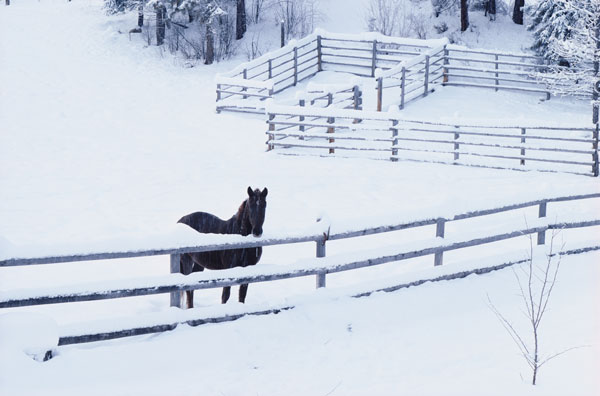
Horses fight the elements by using more energy to maintain body temperature.As a general rule, a 1 percent increase in the energy requirements is needed to replace energy loss from the cold weather for each degree the temperature falls below the horse's thermo-neutral zone (lower critical temperature).A horse manager cannot just provide additional feed to offset loss of body condition.
December 22, 2011

People combat cold weather by putting on additional clothing; horses fight the elements by using more energy to maintain body temperature.
But while most people can address their own needs, horses are dependent upon their owners to provide proper nutrition and protection from the weather, said Dave Freeman, Oklahoma State University Cooperative Extension equine specialist.
“The temperature below which a particular horse starts to expend additional energy for maintaining body warmth (critical temperature) will vary because of fat cover, hair thickness, acclimatization of the horse to cold, hair-coat wetness and wind chill,” he said.
For example, a horse with short hair, exposed to wet, cold weather, may need significantly more energy when the temperature gets below 50 degrees Fahrenheit. A horse acclimatized to cold weather, with a thick hair coat and fat cover, may not expend appreciably more energy until the temperature drops below 30 degrees Fahrenheit.
As a general rule, a 1 percent increase in the energy requirements is needed to replace energy loss from the cold weather for each degree the temperature falls below the horse's thermo-neutral zone (lower critical temperature).
In other words, a horse manager would have to supply roughly two pounds more feed for each 10 degrees Fahrenheit below the critical temperature per day when horses are consuming typical hay and grain rations, a situation that is not practical.
“That’s why horses need to be preconditioned for cold weather by increasing fat thickness and body condition before the onset of winter,” Freeman said.
Freeman cautions that a horse manager cannot just provide additional feed to offset loss of body condition.
“Sudden changes in grain composition and amounts will increase the incidence of colic and founder,” he said. “It’s best to make adjustments in grain gradually over a period of several days, especially if horses already are consuming large quantities of grain.”
Horse managers also should consider feeding large amounts of grass hay to horses restricted from forage. Free-choice hay helps horses exposed to cold weather, partly because of the heat generated by digestion and also as an aid to a continual, safe supply of nutrients.
A concern with providing free access to hay is maintaining a fresh hay supply in ways which reduce hay waste. Large hay losses usually occur when round bales are placed on the ground in pens of horses.
“Those who have elevated hay feeders large enough to hold round-bales need to use them,” Freeman said. “No matter the method, hay exposed to wet weather for any length of time generally will require removal because of decreased palatability and potential problems resulting from horses ingesting moldy hay.”
Provide shelter
Another way horse owners can lessen an equine’s stress resulting from exposure to cold weather is to provide some form of shelter from wind, rain and cold. Some pastures provide enough natural protection that man-made shelters are not required.
“Owners housing horses in areas unprotected from wet, windy weather should consider constructing windbreaks or sheds,” Freeman said. “The cost of windbreaks and sheds will be partially offset by savings in feed costs as a horse’s energy requirements lessen.”
Freeman reminds owners to consider horse instincts and herd pecking orders when deciding on windbreak or shed design. Those areas housing one or two horses that are compatible with one another will allow for an enclosed shed with three or four sides. These structures should be similar in size to recommendations for stalls, a 10-feet- by-10-feet minimum for one horse.
The same type of structure will not work in pens with large numbers of horses or bands of horses with large ranges in horse dominance orders.
“An enclosed, sided structure may increase horse injury to horses on the low end of the herd dominance order by the more dominant horses,” Freeman said. “This type of structure may be inefficient because dominant horses will keep others from having access.”
Freeman recommends single-sided windbreaks with a top cover be used in herds with dominance problems.
“Also, owners should consider two or three of these structures spread about the area because one long, continuous structure is easily guarded by dominant horses,” he said. “Structure dimensions will depend on the degree of herd dominance problems.”
In situations where aggressive behavior becomes such a problem that horses need to be separated, horses on the low end of the herd order generally will need more shelter because they are the ones that are usually in the least favorable body condition.
You May Also Like



